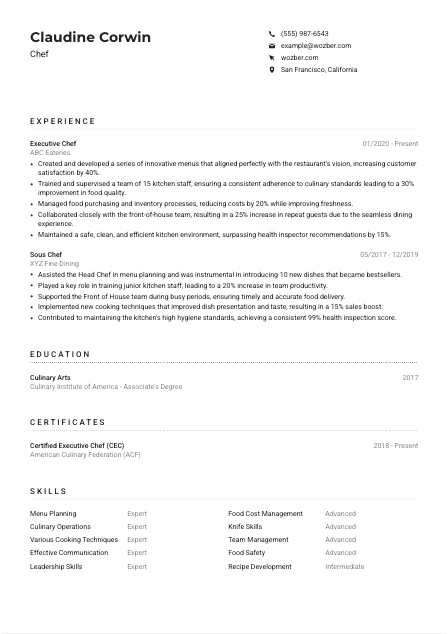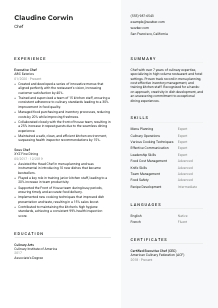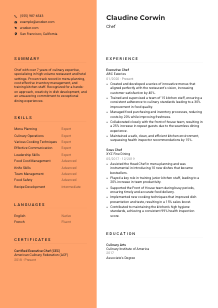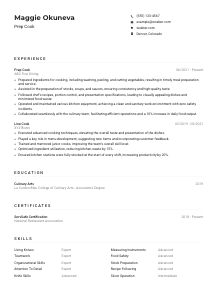Chef Resume Example
Mastering flavors, but your resume lacks seasoning? Dive into this Chef resume example, crafted with Wozber free resume builder. Learn how you can plate up your culinary expertise to suit job recipes, and make sure your career is a sizzling success!

How to write a Chef Resume?
Ah, the delicate art of resume crafting – a task as nuanced as perfecting your signature dish. As a Chef in the bustling culinary scene, standing out in a sea of applicants requires more than just a sprinkle of seasoning on your resume. It demands a deep dive into the alchemy of words, tailored experiences, and a dash of creativity. Partnering with the Wozber free resume builder, let's embark on a gastronomic journey to create an ATS-compliant resume that not only ticks all the checkboxes but adds that 'wow' factor to your application.
Ready to cook up a storm? Let's turn the heat up!
Personal Details
Begin your resume as you would a meal – with an appetizing introduction. Your personal details are the appetizer, setting the stage for what's to come. Here's how to perfect this section with a Chef's finesse.
1. Garnish with Your Name
Present your name boldly, like the signature on your culinary creations. Ensure it's the centerpiece, clearly legible and appetizing at first glance.
2. Plate Your Title
Directly beneath your name, present your title – ‘Chef'. This confirms your identity in the culinary world, instantly connecting with the job you're applying for.
3. Add Your Contact Information
List your most accessible contact number and a professional email. Think of these as the essential ingredients that allow potential employers to reach out for a taste test.
4. Season with Location
Mentioning "San Francisco, California" satisfies the local palate, confirming your availability in the preferred dining area without the need for relocation.
5. A Dash of Professional Online Presence
Considering adding a link to your LinkedIn profile or personal website to let employers peek into your kitchen and taste your professional flavor.
Takeaway
Like the first course of a grand meal, your Personal Details should be inviting and well-presented. It's about giving a taste of who you are, professionally served.





Experience
Your experience is the meat of your resume, rich with flavors of past achievements and professional growth. Here's how to cook it to perfection.
- Created and developed a series of innovative menus that aligned perfectly with the restaurant's vision, increasing customer satisfaction by 40%.
- Trained and supervised a team of 15 kitchen staff, ensuring a consistent adherence to culinary standards leading to a 30% improvement in food quality.
- Managed food purchasing and inventory processes, reducing costs by 20% while improving freshness.
- Collaborated closely with the front‑of‑house team, resulting in a 25% increase in repeat guests due to the seamless dining experience.
- Maintained a safe, clean, and efficient kitchen environment, surpassing health inspector recommendations by 15%.
- Assisted the Head Chef in menu planning and was instrumental in introducing 10 new dishes that became bestsellers.
- Played a key role in training junior kitchen staff, leading to a 20% increase in team productivity.
- Supported the Front of House team during busy periods, ensuring timely and accurate food delivery.
- Implemented new cooking techniques that improved dish presentation and taste, resulting in a 15% sales boost.
- Contributed to maintaining the kitchen's high hygiene standards, achieving a consistent 99% health inspection score.
1. Deconstruct the Job Requirements
Like dissecting a recipe, examine the job description for key ingredients - the skills and experiences sought by the employer.
2. Present Your Professional Journey
Chronologically arrange your roles, starting from the most recent. Each position is a layer in your career dish, adding depth and flavor.
3. Detail Your Culinary Achievements
Each role should be garnished with achievements that resonate with the job description, such as "Created and developed series of innovative menus, aligning with the restaurant's vision".
4. Quantify Where Possible
Incorporate metrics to give scale to your achievements, akin to sharing the number of covers served on a busy night or the percentage cost saved through efficient sourcing.
5. Relevance Above All
Keep the content refined to the essence of culinary arts. Non-relevant experiences are like unwanted garnishes; they can distract from the main flavors of your dish.
Takeaway
A well-crafted experience section tells the story of your culinary journey, showcasing your growth, creativity, and precision. Let it be a testament to your ability to lead kitchens and delight pallets.
Education
In the culinary world, where your skills and creativity take the front seat, your education still plays a vital support role. It's the sous chef to your executive chef role on this resume. Here's how to detail it with care.
1. Identify the Key Educational Flavors
Extract the educational essence from the job posting – in this case, a "Degree or certificate in Culinary Arts from an accredited institution".
2. Craft a Simple Yet Elegant Layout
Your education should be presented cleanly and succinctly. Think of it as plating - the simpler, the more elegant and pleasing it is to the eye.
3. Tailor to the Dish
Align your listed education with the job requirement, showcasing your exact degree or certificate as its prime ingredient.
4. Mention Relevant Courses or Achievements
Season this section with courses or accomplishments that demonstrate your passion and further qualifications for being a chef – like a special workshop or a culinary award.
5. Reflect Your Passion for Continuous Learning
Showcase any additional culinary workshops or certifications you've pursued. It reflects your continual commitment to mastering the craft, just like chefs constantly explore new recipes and techniques.
Takeaway
Though it might sit quietly beside the flamboyant experience section, your education is fundamental, providing the foundational knowledge upon which your culinary skills are built. Serve it well!
Certificates
In the realm of culinary arts, certain certificates are like coveted recipes, setting you apart in a competitive landscape. Here's how to add this special sauce to your resume.
1. Sift Through the Job Flavor Profile
First, decode the job description for any specified certifications. For the Chef role, it might silently scream for recognized culinary certifications.
2. Select the Best Ingredients
Choose the certificates that best align with the job specifications. For instance, a "Certified Executive Chef (CEC)" directly lifts your profile.
3. Freshen Up the Dates
Ensure your certificates are current, or note the period of validity. It's like proving your ingredients (skills) are fresh and up to date.
4. Always Hungry for More
Indicate your drive for continuous learning and improvement by pursuing new certifications or renewing old ones. It shows you're always on the trend, much like a chef keeping up with culinary trends.
Takeaway
Just as a special sauce can elevate a dish, your certificates can significantly boost your resume, making it more appetizing to potential employers. Serve it with pride, knowing it adds exceptional flavor to your application.
Skills
Your skillset is the assortment of spices that gives your culinary profile its distinctive flavor. Here's how to curate and present them to excite the employer's palate.
1. Mix the Essential Spices
Start by listing skills directly mentioned in the job description, like "Strong proficiency in menu planning, food cost management, and culinary operations."
2. Measure Your Spices
Be selective. Focusing on the most relevant skills ensures your resume isn't overly seasoned, allowing each qualification to stand out distinctly.
3. Organize Your Spice Rack
Keep this section well-organized. Divide your skills into 'hard' and 'soft' categories, simplifying it for the hiring manager to digest and appreciate your professional flavor.
Takeaway
Skillfully presenting your capabilities is akin to mastering the use of spices. Each skill adds depth and complexity to your professional persona, leaving the employer craving more.
Languages
The ability to communicate in different languages in the culinary world is much like adding complementary flavors to a dish. It can enhance the overall experience and make your offerings more appealing to a wider audience. Here's how to showcase this asset.
1. Identify The Base Language
Ensure you list English proficiency upfront, as stated in the job description, ensuring you meet the basic communication ingredient.
2. Add Your Linguistic Flavors
Introduce other languages you know, ranking them in order of proficiency. This shows you're capable of catering to a diverse palate.
3. Be Clear About Your Level of Proficiency
Use specific terms like 'Native', 'Fluent', 'Intermediate', and 'Basic' to accurately describe your proficiency level, giving a clear picture of your linguistic capabilities.
4. Understand the Dish's Requirements
For a Chef, especially in international cuisines or diverse settings, multilingual skills can prove invaluable, enhancing your recipe for success.
5. Always Looking to Add More
Express your openness to learning more languages, just as a chef is always willing to experiment with new ingredients and techniques.
Takeaway
Languages can significantly enrich your professional offering, making you an appealing candidate to a broader audience. It's the extra touch that can turn a great dish into an unforgettable one.
Summary
In a beautifully curated menu, the amuse-bouche is offered as a glimpse into the chef's art, setting the tone for the meal. Similarly, the summary of your resume is a flavorful bite-sized introduction to your professional self. Here's how to make it delightful.
1. Capture the Essence
Begin with a succinct statement that encapsulates your culinary career and passion. This snapshot should quench the employer's appetite to know more about you.
2. Craft with Key Ingredients
Reference specific skills and achievements that align with the job's requirements, like your knack for "Increasing customer satisfaction by 40% with innovative menus".
3. Distill to Perfection
Your summary should be potent, containing only the most compelling and relevant information, much like reducing a sauce to intensify its flavor.
4. Keep It Savory & Sweet
While brevity is key, ensure your summary leaves a memorable taste – a balance of your professional prowess and personal zest.
Takeaway
Just as the amuse-bouche offers a hint of the chef's talent, let your summary intrigue and invite the employer to explore the rest of your resume. Craft it as you would your signature dish, with care, creativity, and passion.
Launching Your Chef Journey
As we plate this guide, remember that crafting an ATS-compliant resume with Wozber is like having a sous-chef by your side. Utilize the free resume builder, ATS-friendly resume templates, and ATS resume scanner to ensure your resume not only meets the job requirements but surpasses them. Your resume is a reflection of your culinary journey, disciplined craft, and creative flair. Serve it with confidence, and let it be the passport to your next great adventure in the culinary world.
The kitchen awaits your mastery. Bon appétit!

- Minimum of 5 years of professional culinary experience, preferably in a high-volume restaurant or hotel setting.
- Degree or certificate in Culinary Arts from an accredited institution.
- Strong proficiency in menu planning, food cost management, and culinary operations.
- Exceptional knife skills and expertise in various cooking techniques.
- Effective communication and leadership skills to manage a kitchen team.
- English proficiency is a key skill for this position.
- Must be located in San Francisco, California.
- Create and develop innovative menus that align with the restaurant's vision and customer preferences.
- Train, supervise, and schedule kitchen staff ensuring all culinary standards are met.
- Maintain a safe and clean kitchen environment, following all food safety and sanitation guidelines.
- Manage food purchasing and inventory, ensuring optimal freshness and cost efficiency.
- Collaborate with front-of-house staff to ensure a seamless dining experience for guests.















